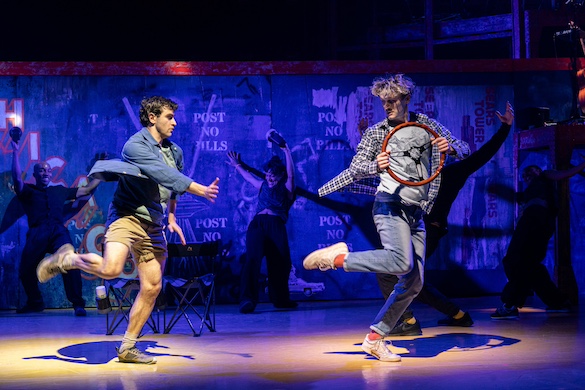‘Illinoise’ Gathers Viewers Around Campfires and Shares Spellbinding Stories — Wordlessly
Director Justin Peck and playwright Jackie Sibblies Drury have fused dance and musical theater to craft a series of narratives that ruminate on love and loss. The lack of dialogue is a testament to a central tenet of both art forms.

Campfire stories have the power to terrify, thrill, haunt, and inspire. In the ravishing new work that is “Illinoise,” they do all these things — without requiring a single spoken word.
Now having its New York City premiere, this 90-minute piece is based on singer/songwriter Sufjan Stevens’s 2005 album “Illinois” and uses that sprawling, majestic collection as its score. But this is no jukebox joint: Rather, choreographer and director Justin Peck — the New York City ballet wunderkind also noted for his work on Broadway and in Steven Spielberg’s screen adaptation of “West Side Story” — and a Pulitzer Prize-winning playwright, Jackie Sibblies Drury, have fused dance and musical theater to craft a series of narratives that ruminate on love and loss to spellbinding effect.
That “Illinoise” features no dialogue is a testament to a central tenet of both art forms: Sometimes mere speech cannot accommodate the scope and depth of our feelings. And since emotions can run especially deep earlier in life, Mr. Peck and Ms. Sibblies Drury introduce us to a group of scruffy young bohemians, evocatively costumed by Reid Bartelme and Harriet Jung, who gather around a pile of orb-like lights, suggesting that campfire — though Adam Rigg’s scenic design, with its steel scaffolding and sparse, inverted trees, has a distinctly urban vibe.
The tales that unfold, spun from the memories and imaginations of five “storytellers,” take us to a variety of other settings, from a small town where two lads forge a doomed friendship to a convocation of zombies and, creepier still, the lodgings of a serial killer, John Wayne Gacy. Social commentary is sprinkled in; the lurching zombies, for instance, are shown to be controversial men from our past, among them presidents Andrew Jackson and Ronald Reagan — both called out in Mr. Stevens’s songs.

One storyteller, played by the extraordinary dancer Rachel Lockhart — one of a few alumni of TV’s “So You Think You Can Dance” in the company — expresses what the program describes as her “attempts to understand a lineage, and find the lessons left by those who came before.” If that sounds vague, Ms. Lockhart, who is Black (the company is racially diverse), and Mr. Peck give it purpose and urgency with movement that, like all the routines here, evokes exploration and exhilaration.
Like all great choreographers, Mr. Peck understands that dancing is really physical acting, and so do his performers. As they push through and against space, you can almost feel them reaching toward the realization of dreams and away from pain. Mr. Peck serves the textural range of Mr. Stevens’s music, incorporating tap and street dance as well as the classical tradition in which he’s rooted. His cast includes a former City Ballet principal, Robbie Fairchild, charming as a storyteller who imagines a sensitive Superman, alongside Gaby Diaz, whose credits include “So You Can Think…” and Jennifer Lopez’s Las Vegas show.
Ms. Diaz is featured in the longest and ultimately most harrowing story in “Illinoise,” involving two buddies and their lovers and tragedy that’s less grisly and more commonplace than the kind featured in the Gacy segment. Ben Cook, Ahmad Simmons, and Ricky Ubeda join her, all using their full bodies to convey playfulness, disappointment, tenderness, and grief.
The players get soaring accompaniment from a band conducted by Nathan Koci, who also plays keyboards and banjo, and from folky, angelic vocals provided by Elijah Lyons, Shara Nova, and Tasha Viets-VanLear. (Mr. Koci and his musicians lend backing vocals, while Mr. Lyons also plays keyboards and Ms. Nova and Ms. Viets-VanLear play electric guitar.) The singers sport fanciful butterfly wings, which seems appropriate, given how this production flies — almost literally, it can seem — from yearning to sorrow to profound, joyful transcendence.

